Space Launch System: NASA's megarocket for Artemis moon missions
The Space Launch System will one day propel humans to the moon.
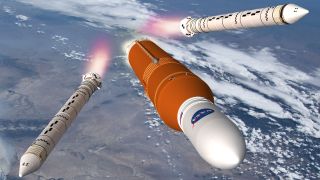
NASA's Space Launch System (SLS) will carry humans beyond the grasp of Earth's gravity, stretching to the moon, Mars and perhaps, one day, deep space. The first destination is the moon.
The new heavy-duty launch vehicle will be the world's most powerful rocket designed to carry unmatched payloads into deep space. Unlike any other space rocket, the SLS has been created to evolve alongside advancing technology. Its modular design and interchangeable parts means that it can evolve alongside growing technologies and varying mission goals.
The launch vehicle
The SLS comes in an array of elements that will evolve and vary, depending on whether the vehicle carries a crew or cargo.
Engines, boosters and core stage
The first few iterations of SLS will contain a pair of solid-rocket boosters capped with four RS-25 engines. Most of the engines planned for each launch vehicle are space-shuttle veterans that have undergone rigorous testing. According to NASA, "The RS-25 is one of the most-tested large rocket engines in history, with more than 3,000 starts and over a million seconds of total ground test and flight firing time over 135 missions."
The four liquid-propellant engines at the base of each rocket, combined with solid-rocket boosters, will push the SLS into orbit during its 8-minute climb toward space. Like the engines, the solid-propellant boosters were qualified by the space shuttle program, though they've been modified to work with SLS. As technology evolves, the solid-rocket boosters will be swapped out for advanced boosters.
The long, thin "rocket" structure known as the core stage rises more than 200 feet (61 meters) tall between the boosters, and will carry 730,000 gallons (2.76 million liters) of supercooled liquid hydrogen and liquid oxygen to power the engines.
The Orion spacecraft
NASA's Orion crew module will carry crews into space, though none will be onboard during the first test mission. Drawing from more than half a century of research and development, the Orion module plans to be flexible enough to carry humans to a variety of destinations.
The entire craft includes a crew and service module, a spacecraft adaptor to connect the module to the powerful rockets beneath, and a new launch-abort system.
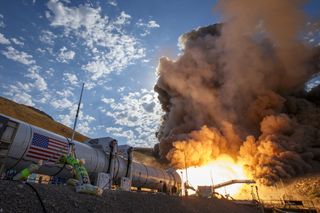
Although Orion is relatively new, the spacecraft underwent rigorous testing in preparation for carrying humans away from Earth. The abort system, which will provide the crew with the ability to escape if an emergency occurs on the launch pad, was successfully tested at White Sands Missile Range in New Mexico, in 2010.
An array of tests confirmed Orion's ability to withstand launch, abort, re-entry and spaceflight overall. At sea and at NASA's Hydro Impact Basin, the agency tested how the module will fare when it splashes down in the ocean at the end of its mission. Orion also underwent a series of parachute tests that wrapped up in 2018.
The capsule achieved a 4.5-hour low-orbit test flight around Earth back in December 2014, called the Exploration Flight Test-1.
A series of missions
Unlike previous human launch systems, SLS is designed to grow and evolve over time. The vehicle includes multiple launch configurations that will carry cargo and crew into the darkness of space. The SLS system's flexibility enables engineers to utilize one design today but adapt to future missions.
Artemis 1
Standing more than 322 feet (98 m) tall, the first Block 1 configuration of SLS will carry an uncrewed Orion spacecraft to a stable orbit beyond the moon and then return the craft safely home. The Artemis 1 mission, formerly known as Exploration Mission-1 (EM-1), will see the SLS travel 280,000 miles (around 450,000 kilometers) from Earth over the course of 4 to 6 weeks.
Although the first mission won't be carrying people, SLS won't exactly be empty. When the rocket launches, it will carry more than a dozen cubesats, which are small satellites — not much bigger than a breadbox — capable of collecting data on their own.
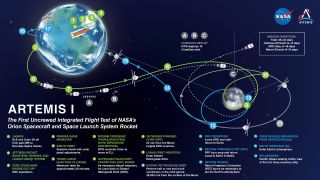
"The first SLS launch presents a great opportunity to collaborate with our international partners by providing rides for cubesats that can pursue independent science and technology missions while supporting our mutual goals for human exploration in deep space," Steve Creech, acting manager of the Spacecraft and Payload Integration and Evolution Office, said in a 2016 statement.
The mission is scheduled to launch in May 2022, however, there is speculation this could slip into June or July 2022.
Artemis 2
The second mission, Artemis 2, will follow a similar configuration to that of Artemis 1. This time, however, the Orion capsule will carry several astronauts into the region of space past the moon. Because of its human payload, during Artemis 2, the Orion capsule, along with the upper stage of the SLS, known as the cryogenic propulsion stage (ICPS), will orbit the Earth twice — rather than the single orbit of Artemis 1 — before heading moonward.
This is to ensure all systems are working optimally, while the crew are still relatively close to Earth. The onboard crew will journey 4,600 miles beyond the far side of the moon before returning home. The mission is expected to last just over 10 days.
The launch of Artemis 2 is scheduled for 2023 from NASA’s Kennedy Space Center in Florida.
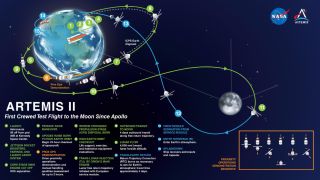
Artemis 3
In Artemis’s third mission instalment, the goal has allowed humans to walk on the moon since 1972. In April 2021, NASA announced that SpaceX would be the company awarded the development contract to construct an integrated human landing system to put people back on the moon.
SpaceX is growing closer to achieving this goal with its 20th generation Starship prototype. The Starship is a Super Heavy duty rocket that is built to carry a payload above 110 tons (100 metric tons). Unlike the SLS, STarship is reusable and not only sends cargo into space but is designed to also land back on the surface. It’s hoped that NASA and SpaceX will be ready to launch in 2024.
Different configurations
Block 1B
The next set of missions require the SLS Block 1B configuration. This version will be approximately 364 feet (111 m) tall, towering above the historic Saturn V rocket that carried astronauts to the moon. In addition to carrying the Orion module, the Block 1B can carry exploration systems, such as a small, deep-space habitat module.
"The second configuration of SLS, known as Block 1B, will be the workhorse of the proving ground phase of NASA's journey to Mars," Creech said. "The rocket will carry crew and exploration systems tens of thousands of miles beyond the moon to demonstrate new capabilities that will enable us to then move outward toward the Red Planet."
Or, the module could be swapped out for a payload configuration that can carry larger exploration systems or science spacecraft instead of people. "While many people think of the Space Launch System in terms of human exploration, SLS could have a wide application in a lot of other areas, including space science," Creech said in a 2014 statement.
"For missions to the outer planets, for example, SLS could make it possible to do things that are currently impossible, such as sending larger scientific spacecraft with more instruments to far off destinations with reduced transit times."
Such missions could include supporting the proposed mission to Jupiter's icy moon Europa. According to NASA, the transit time for the Europa Clipper could be reduced to less than half of what's needed by other launch vehicles.
"The potential use of SLS for science will further enhance the synergy between scientific exploration and human exploration," John Grunsfeld, astronaut and former associate administrator for science at NASA Headquarters in Washington, said in a statement. "SLS has the promise of enabling transformational science in our exploration of the solar system and cosmos."
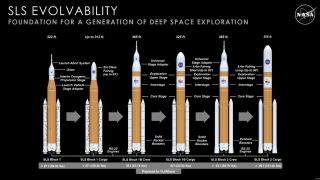
Block 2
Only after astronauts have performed several deep-space missions to the moon will NASA consider using the Block 2 configuration as the primary transport for a human mission to Mars. The most advanced SLS configuration will tower above its predecessors at a whopping 365 feet (111 m) high.
"The Space Launch System could be really game-changing for space science," Reggie Alexander, manager of NASA's Advanced Concepts Office, said in a 2014 statement.
"For some missions, it makes it much easier and quicker to carry them out. A Mars sample return mission, for example, could be flown using only one rocket instead of three. But for other destinations, SLS lets you do things we could only dream of before — like collecting samples from the geysers of Saturn's moon Enceladus."
Additional resources
For all the details on the Space Launch System and its future missions, NASA’s SLS webpage has all the information. For more information about the early moon missions, check out “A Man on the Moon: The Voyages of the Apollo Astronauts” by Andrew Chaikin and “Apollo's Legacy: Perspectives on the Moon Landings” by Roger D. Launius.
Bibliography
- Kathryn Hambleton, “Around the Moon with NASA’s First Launch of SLS with Orion”, NASA, November 2021.
- Kathryn Hambleton, “NASA’s First Flight With Crew Important Step on Long-term Return to the Moon, Missions to Mars”, October 2021.
- NASA, “America’s Rocket for Deep Space Exploration”, accessed March 2022.
- NASA, “NASA’s Space Launch System: Reference Guide”, accessed March 2022.
- NASA, “NASA’s Lunar Exploration Program Overview”, September 2020.
- Jeff Foust, “NASA’s Space Launch System Will Lift Off”, IEEE, December 2021
Join our Space Forums to keep talking space on the latest missions, night sky and more! And if you have a news tip, correction or comment, let us know at: community@space.com.
Get the Space.com Newsletter
Breaking space news, the latest updates on rocket launches, skywatching events and more!

Nola Taylor Tillman is a contributing writer for Space.com. She loves all things space and astronomy-related, and enjoys the opportunity to learn more. She has a Bachelor’s degree in English and Astrophysics from Agnes Scott college and served as an intern at Sky & Telescope magazine. In her free time, she homeschools her four children. Follow her on Twitter at @NolaTRedd
- Elizabeth HowellStaff Writer, Spaceflight
- Scott DutfieldContributor
